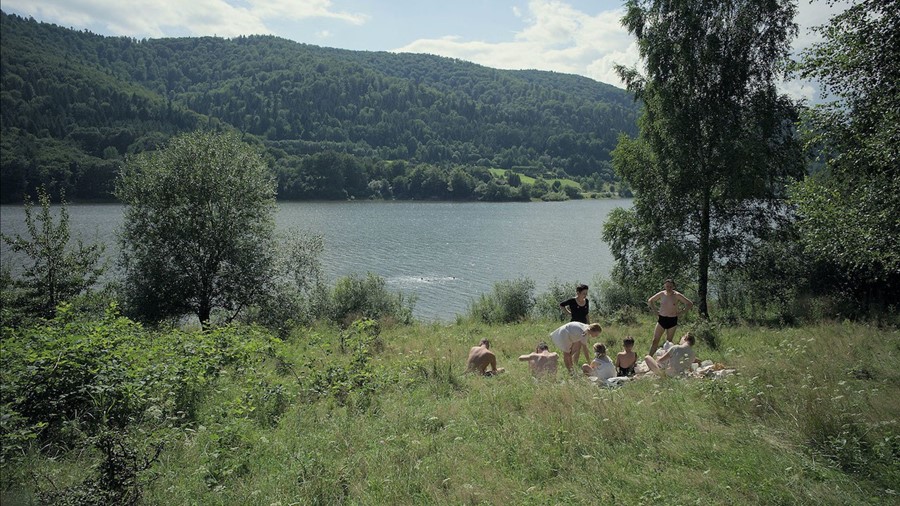Screened at BFI London Film Festival, Jonathan Glazer’s first feature in ten years keeps the drama purposely low-stakes to heighten our horror at what’s taking place around the edges of the frame
Jonathan Glazer is the enigmatic talent who gave us Under the Skin and Birth, films whose warped beauty and beady, clinical eye owe a clear debt of influence to Stanley Kubrick, whose career he seems to be imitating in more ways that one: The Zone of Interest arrives some ten years since the release of his last film.
Daringly conceived and chillingly executed, Glazer’s fourth feature to date takes a novel by the late Martin Amis, guts it of nearly all plot, and confronts us at length with a central, crushing irony. It’s the story of a Nazi death camp commandant and his family, living in an idyllic country home right next door to Auschwitz.
That commandant, Rudolf Höss, was a real-life figure, responsible for the murder of a million people during the second world war. Played with a quiet, reedy tenor by Christian Friedel, Höss is seen mostly at home with his wife, Hedwig (Toni Erdmann’s Sandra Huller), and their five children in what seems to be a loving family setting. (Though the silence of their domestic staff suggests something else.) In a sense, very little that happens in the foreground of the film can really be said to ‘matter’, Glazer keeping the drama purposely low-stakes to heighten our horror at what’s taking place around the edges of the frame. Thus we get scenes of Hedwig fretting over her garden while the crematoria chimneys pump out smoke, or kids playing in the pool as steam-engine trails track the progress of trains bringing prisoners to the camp. In one awful scene, Höss blows ashes from his nose in the bathroom, a moment that recalls Chinua Achebe’s poem Vultures, the “scent of human roast” still clinging to a prison guard who brings sweets home to his children.
Glazer brings us all of this and more, but the irony can be wearying. Paul Schrader complained that the film was more like a “parlour trick” than a serious examination of Nazi crimes against humanity, and certainly, there are moments where the sleight-of-hand conceit rubs awkwardly against the seriousness of the endeavour: the one time we see Hoss at work in the camp, it’s in portrait from a low angle, the noise from the camp the only clue as to what’s really going on. Glazer’s film tries to look the thing in the eye by refusing to look the thing in the eye, but how much can we look away? Mileage may vary.
That said, we do get flashes of insight into these characters’ inner lives, and if the film has a theme beyond the banality of evil it’s the ability of people to withstand the presence of obscenity. For as much as the carnage is kept hidden from view in the Hoss’s home, we can see the ways in which it begins to infect their children’s behaviour. And Hedwig’s mum, who beams with pride at her daughter’s home when she comes to stay with the family, soon flees after a night spent gazing into the furnace glow of the neighbouring camp. This in turn leads to another bone-chilling moment, the closest perhaps any character comes to giving voice to the evil at hand here, when Hedwig scolds a maidservant for an imagined slight.
Understandably, Glazer dials down his signature style for much of the film. His camera is dead, motionless, underscoring the flat quality of the film’s drama that’s unfolding – though we do get some dreamlike scenes shot in negative black and white, where a servant creeps out at night to plant apples in the mud for the starving prisoners. Mica Levi, whose music was so integral to the mood of Under the Skin, contributes two infernal pieces that bookend the film, but the real soundtrack is the diabolical background hum of heavy machinery, screams and scattered rifle fire, all deployed carefully to underscore moments of dramatic irony.
For the last half hour, the film’s action shifts to Oranienburg, Berlin, Hoss rubbing shoulders with Nazi top brass as they draw up plans for the final solution. In what is perhaps the film’s most affecting moment, we flash forward to the present in what might be a vision, workers at the Auschwitz museum diligently sweeping and scrubbing at the gas chambers that now serve as memorials. The effect is strangely ambiguous, which is more than we can say for the rest of a film that walks a vanishingly thin line between exactingly cold and callous.
